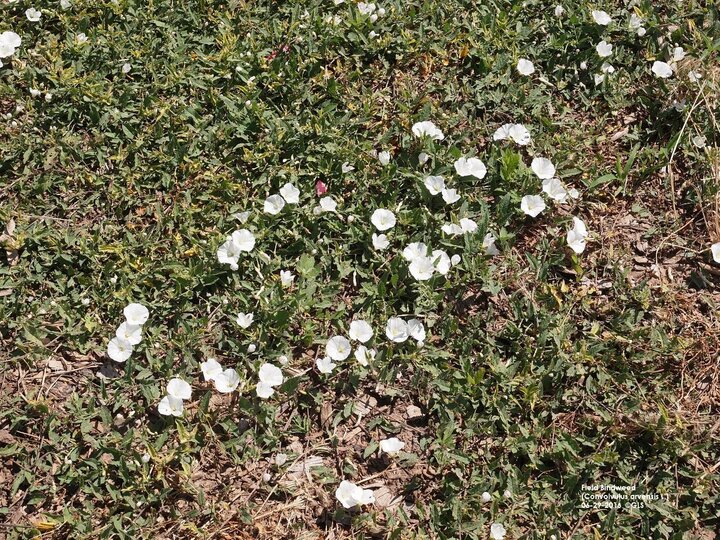Early Detection and Rapid Response (EDRR) is a concept to identify potentially invasive species prior to or just as the establishment of the invasive is taking place. An Integrated Pest Management plan (IPM) can be developed to manage, contain and eradicate the invasive species before it can spread further. This will avoid costly, long-term control efforts.
Field Bindweed
a.k.a. – Small bindweed, European bindweed, Creeping Jenny
Scientific name: Convolvulus arvensis L.
Family: Convolvulaceae (Morningglory family)
Description
Origin: Eurasia. Introduced into the United States as a contaminant in farm and garden seeds in the mid-1700s. It has been reported in every state in the United States and is a noxious weed in 22 states.
Field bindweed is non-native, long-lived perennial rhizomatous forb. It has an extensive deep fibrous root system and reproduces/spreads from seed and roots. A Field bindweed plant can produce up to 600 seeds per year, which 90% are viable. Approximately 25% of these seeds will germinate immediately while the remainder can remain viable for 60 years or more. Seeds can germinate throughout the growing season, from 40° to 100°F soil temperature, when adequate moisture is available. Seed is dispersed by movement of affected soil, wildlife, harvest equipment and harvested crops. The plant can spread 10 to 18 feet through its roots each year. Roots can grow to a depth of 20 feet in the soil, but 90% of the plant’s roots are generally in the top foot of soil. New plants have been found to grow from roots and root buds as deep as 14 feet.
Field bindweed produces shoots / vines that grow in a spiral fashion, horizontally or vertically, that can form dense tangled mats. Leaves can be narrow or broad, 1 to 2 inches long and arrowhead shaped. Flowers are white but can be pink in color and are trumpet shaped, approximately 1 inch long and wide. Field bindweed contains alkaloids that are mildly toxic to certain types of livestock and cause digestive disturbances. Productivity of agricultural land may be reduced as much as 50%. Field bindweed is listed as one of the ten most serious weeds in the world.
Habitat
Field bindweed is found in variety of habitats which include agricultural fields, turf, pastures, gardens, roadsides, non-crop sites and disturbed areas. The extensive root system of this plant makes it very hard to manage. It out-competes desirable plants for nutrients and moisture. The twining growth of the plant inhibits harvest of crops and can cause lodging.
Management
Management and control of Field Bindweed is difficult due to its extensive root system and long life of the seeds. Depleting the root reserves of the plant and reducing sprouting is key to successful management. Whichever management methods are selected, it will take time and persistence. An Integrated Pest Management plan must be utilized using more than one option for effective control.
Prevention is the best and cheapest management option. Having well-established perennial grasses and forbs on a maintained pasture or hay field with proper grazing and rotational grazing techniques can go a long way to prevent its establishment.
Know and inspect where topsoil that is trucked in originates. For gardens and turf, check nursery stock prior to purchase, maintain a healthy lawn with proper fertilization, watering and mowing. Proper mulching techniques in flower beds and garden areas can slow the plants spread by preventing light to reach the soil surface. Purchase compost from reputable sources.
Mechanical methods include hand pulling seedling or young adult stage plants, hoeing, tilling or cultivation can be effective. Mechanical methods need to be repeated every two weeks during the growing season. Mowing has not been an effective management tool and burning has limited effect.
There are three insects that are considered biological control methods at this time. These are a tortoise beetle (Chelymorpha cassidea), native to the United States, that feeds on the leaves of the plant. There is a gall forming mite (Aceria malherbae) and the European moth (Tyta luctuosa) that as a caterpillar will defoliate the plant. Establishment of these insects has been poor and little success has been obtained.
There are numerous chemical treatment options available to manage Field Bindweed. Where turf, gardens and flower beds are the sites, pre-emergence products can control germinating seeds. Where possible a systemic herbicide labeled for the site, post-emergence products should be used in conjunction with the pre-emergence product. Systemic herbicides translocate and move through the plant to the root system.
Where agricultural land and pastures are affected, there is a broader range of systemic herbicides available. Products containing aminocyclopyrachlor, clopyralid, chlorsulfuron, dicamba, imazapic, imazapyr, metsulfuron, picloram (Restricted Use), triclopyr, glyphosate (non-selective) and 2,4-D have been shown to work. Timing and rate of product application will depend on the product label and the site / crop. An application of a labeled herbicide at first bloom will help reduce seed production. Additional herbicide applications may be necessary later in the season, if allowed by the herbicide label, to control additional flushes. Tank mixes of several of these herbicides may provide better control. The addition of a non-ionic surfactant to the herbicide mix will aid in control. Re-treatment will be necessary until the seed and root reserves in the soil is exhausted. Be sure to select a product labeled for the site. Read, understand and follow all label instructions when using any pesticide.
References
Beddes, T., et all, “Suppression and Control of Field Bindweed – (Perennial Morning Flory) in Residential Areas”, Utah State University, Horticulture / Weeds / 2017-01pr
Davis, S. & Orloff, N., “Field Bindweed”, Montana State University, MT201903AG, 02-2019
Stubbendieck, J., et al, Weeds of the Great Plains” Nebraska Department of Agriculture, 2019
Thompson, C. “Control Field Bindweed (Convolvulus arvensis) with Other Broadleaf Weeds This Fall” University of Nebraska, turf.unl.edu, 08-2016
Interviews with the authors of BeefWatch newsletter articles become available throughout the month of publication and are accessible at https://go.unl.edu/podcast.

